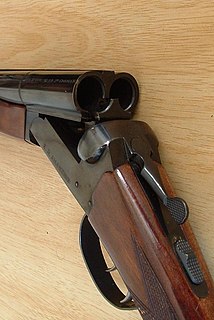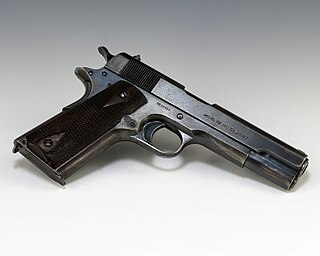
A firearm is any type of gun designed to be readily carried and used by an individual. The term is legally defined further in different countries.

A revolver is a repeating handgun that has at least one barrel and uses a revolving cylinder containing multiple chambers for firing. Before firing a round, cocking the hammer partially rotates the cylinder, indexing one of the cylinder chambers into alignment with the barrel, allowing the bullet to be fired through the bore. The hammer cocking can be achieved by either the user manually pulling the hammer back, via internal linkage relaying a rearward movement of the trigger, or both. By sequentially rotating through each chamber, the revolver allows the user to fire multiple times until having to reload the gun, unlike older single-shot firearms that had to be reloaded after each shot.

Single-shot firearms are firearms that hold only a single round of ammunition, and must be reloaded manually after every shot. The history of firearms began with single-shot designs, then multi-barreled designs appeared, and eventually many centuries passed before multi-shot repeater designs became commonplace.

A derringer is a small handgun that is neither a revolver nor a semi/fully automatic pistol. It is not to be confused with mini-revolvers or pocket pistols, although some later derringers were manufactured with the pepperbox configuration. The modern derringer is often multi-barreled, and is generally the smallest usable handgun of any given caliber and barrel length due to the lack of a moving action, which takes up more space behind the barrel. It is frequently used by women because it is easily concealable in a purse or a stocking.
A semi-automatic firearm, also called a self-loading or autoloading firearm, is a repeating firearm whose action mechanism automatically loads a following round of cartridge into the chamber (self-loading) and prepares it for subsequent firing, but requires the shooter to manually actuate the trigger in order to discharge each shot. Typically, this involves the weapon's action utilizing the excess energy released during the preceding shot to unlock and move the bolt, extracting and ejecting the spent cartridge case from the chamber, re-cocking the firing mechanism, and loading a new cartridge into the firing chamber, all without input from the user. To fire again, however, the user must actively release the trigger, allow it to "reset", before pulling the trigger again to fire off the next round. As a result, each trigger pull only discharges a single round from a semi-automatic weapon, as opposed to a fully automatic weapon, which will shoot continuously as long as the ammunition is replete and the trigger is kept depressed.

The pepper-box revolver or simply pepperbox is a multiple-barrel firearm, mostly in the form of a handgun, that has three or more gun barrels in a coaxially revolving mechanism. Each barrel holds a single shot, and the shooter can manually rotate the whole barrel assembly to sequentially index each barrel into alignment with the lock or hammer, similar to rotation of a revolver's cylinder.
A repeating rifle is a single-barreled rifle capable of repeated discharges between each ammunition reloads. This is typically achieved by having multiple cartridges stored in a magazine and then fed individually into the chamber by a reciprocating bolt, via either a manual or automatic action mechanism, while the act of chambering the round typically also recocks the hammer/striker for the following shot. In common usage, the term "repeating rifle" most often refers specifically to manual repeating rifles, as opposed to self-loading rifles, which use the recoil and/or blowback of the previous shot to cycle the action and load the next round, even though all self-loading firearms are technically a subcategory of repeating firearms.

A gunsmith is a person who repairs, modifies, designs, or builds guns. The occupation differs from an armorer, who usually replaces only worn parts in standard firearms. Gunsmiths do modifications and changes to a firearm that may require a very high level of craftsmanship, requiring the skills of a top-level machinist, a very skilled woodworker, and even an engineer. Gunsmiths perform factory-level repairs and renovations to restore a well-used or deteriorated firearms to new condition. They may make alterations to adapt sporting guns to better fit the individual shooter that may require extensive modifications to the firearm's stocks and metal parts. Repairs and redesigns may require fabrication and fitting of unavailable parts and assemblies constructed by smiths themselves. Gunsmiths may also renew metal finishes or apply decorative carvings or engravings to guns. Many gun shops offer gunsmithing service on the premises.

The .410 bore is one of the smallest caliber of shotgun shell commonly available. A .410 bore shotgun loaded with shot shells is well suited for small game hunting and pest control. The .410 started off in the UK as a garden gun along with the .360 and the No. 3 bore rimfire, No. 2 bore rimfire, and No. 1 bore rimfire. .410 shells have similar base dimensions to the .45 Colt cartridge, allowing many single-shot firearms, as well as some derringers chambered in that caliber, to fire .410 shot shells without any modifications.
William Tranter was a British gunmaker and gun designer famous for inventing the Tranter revolver.

H&R 1871, LLC, or more commonly known as Harrington & Richardson, is an American brand of firearms and a subsidiary of JJE Capital Holdings. H&R ceased production February 27, 2015.

Break action is a type of firearm action in which the barrel or barrels are hinged much like a door and rotate perpendicularly to the bore axis to expose the breech and allow loading and unloading of cartridges. A separate operation may be required for the cocking of a hammer to fire the new round. There are many types of break-action firearms; break actions are universal in double-barrelled shotguns, double-barrelled rifles, combination guns, and are also common in single shot pistols, rifles, shotguns, and can also be found in flare guns, grenade launchers, air guns, and some older revolver designs. They are also known as hinge-action, break-open, break-barrel, break-top, or, on old revolvers, top-break actions.

High Standard Firearms was an American manufacturer of firearms, based in Houston, Texas. The company was founded in Hamden, Connecticut in 1926 as a supplier to the numerous firearms companies in the Connecticut Valley.

A handgun is a short-barrelled firearm designed to be held and used with one hand or two. The two most common handgun sub-types in use today are revolvers and semi-automatic pistols, although other handgun-types such as derringers and machine pistols also see infrequent usage.

A pistol is a handgun, more specifically one with the chamber integral to its gun barrel, though in common usage the two terms are often used interchangeably. The English word was introduced in ca. 1570, when early handguns were produced in Europe, and is derived from the Middle French pistolet, meaning a small gun or knife. In colloquial usage, the word "pistol" is often used to describe any type of handgun, inclusive of revolvers and the pocket-sized derringers.

The Volcanic Repeating Arms Company was an American company formed in 1855 by partners Horace Smith and Daniel B. Wesson to develop Walter Hunt's Rocket Ball ammunition and lever action mechanism. Volcanic made an improved version of the Rocket Ball ammunition, and a carbine and pistol version of the lever action gun to fire it. While the Volcanic Repeating Arms Company was short-lived, its descendants, Winchester Repeating Arms Company and Smith & Wesson became major firearms manufactures.
Robert Hillberg was a firearm designer and the head of Research & Development at the High Standard Manufacturing Company. His designs included the folding shotgun stock, the Whitney Wolverine lightweight pistol, Wildey .45 gas-operated pistol, COP .357 Derringer pistol, and M60 machine gun. Hillberg developed a variety of insurgency weapons, primarily multiple barrel shotguns, which could be covertly distributed to partisan forces fighting in the United States' national interests. Gun Digest editors have described Hillberg as a "national treasure."

A multiple-barrel firearm is any type of firearm with more than one gun barrel, usually to increase the rate of fire or hit probability and to reduce barrel erosion/overheating.
Hopkins & Allen Arms Company was an American firearms manufacturing company based in Norwich, Connecticut, that was founded in 1868 by Charles W. Allen, Charles A. Converse, Horace Briggs, Samuel S. Hopkins and Charles W. Hopkins. The Hopkins brothers ran the day-to-day operations of the company until it went bankrupt in 1916 and was subsequently bought by Marlin-Rockwell.

A repeating firearm, or repeater, is any firearm that is capable of being fired repeatedly before having to manually reload new ammunition into the weapon.
















